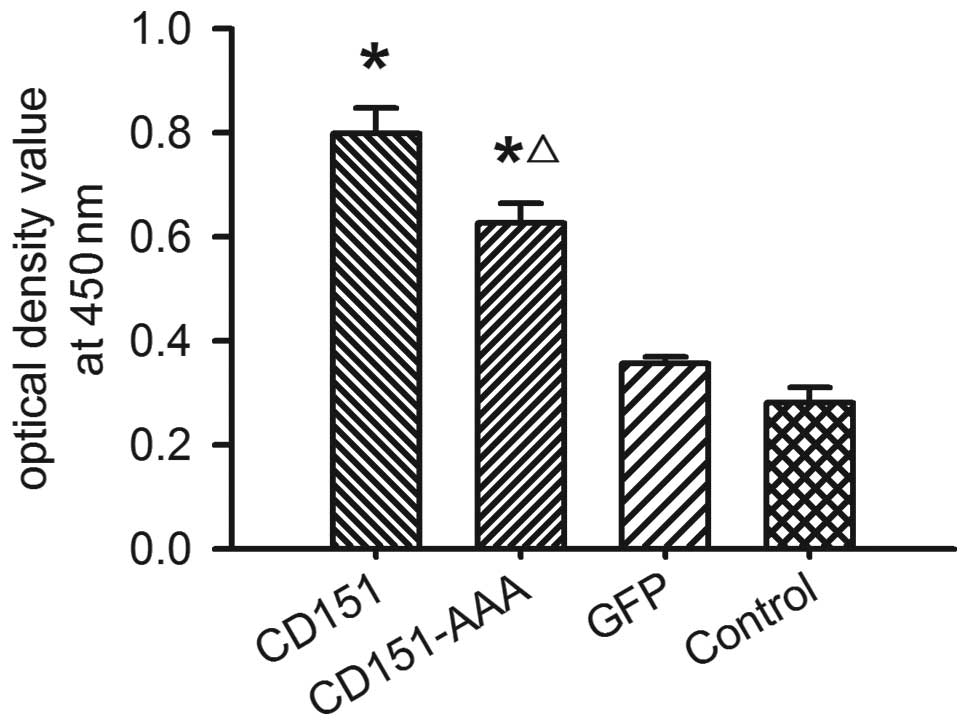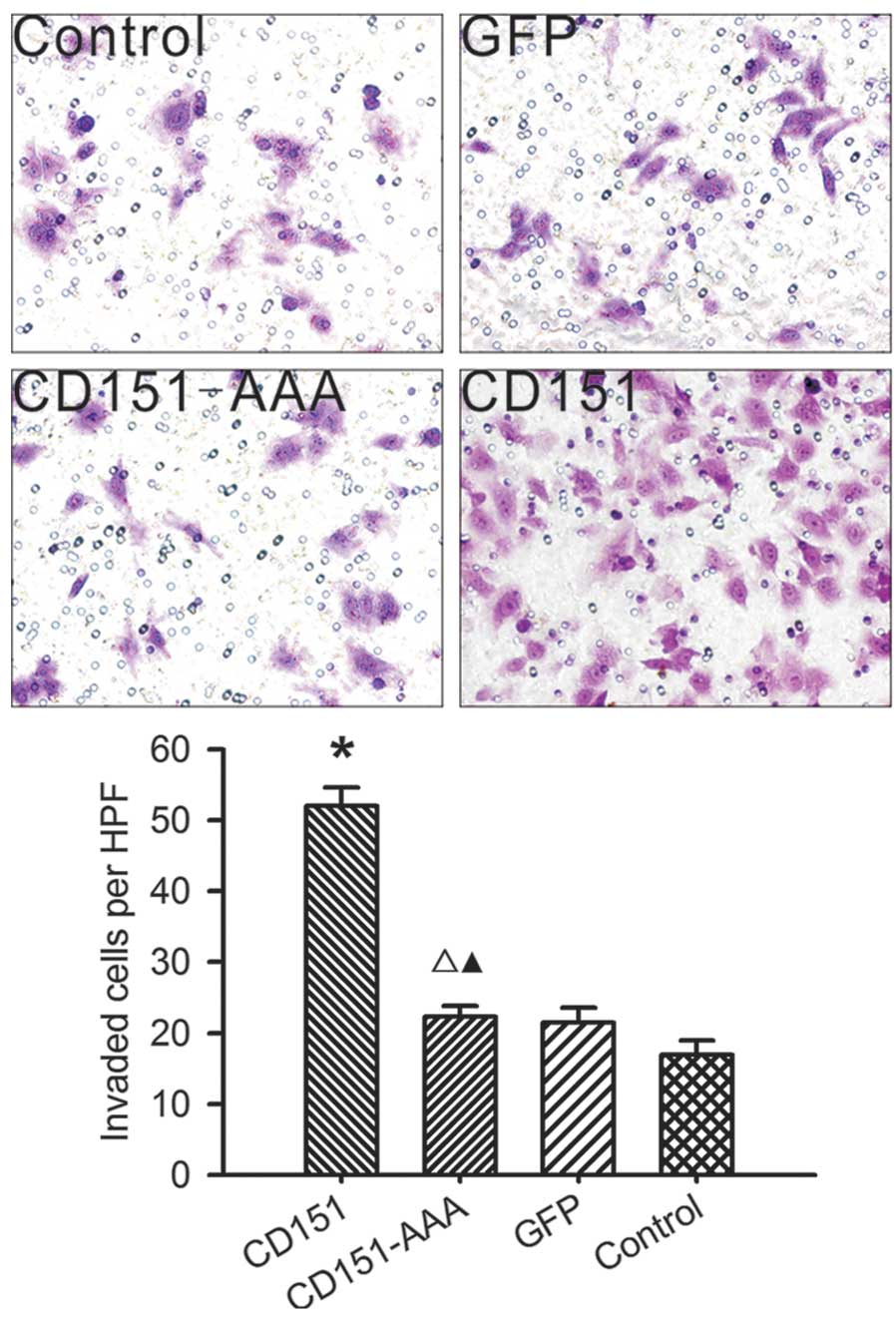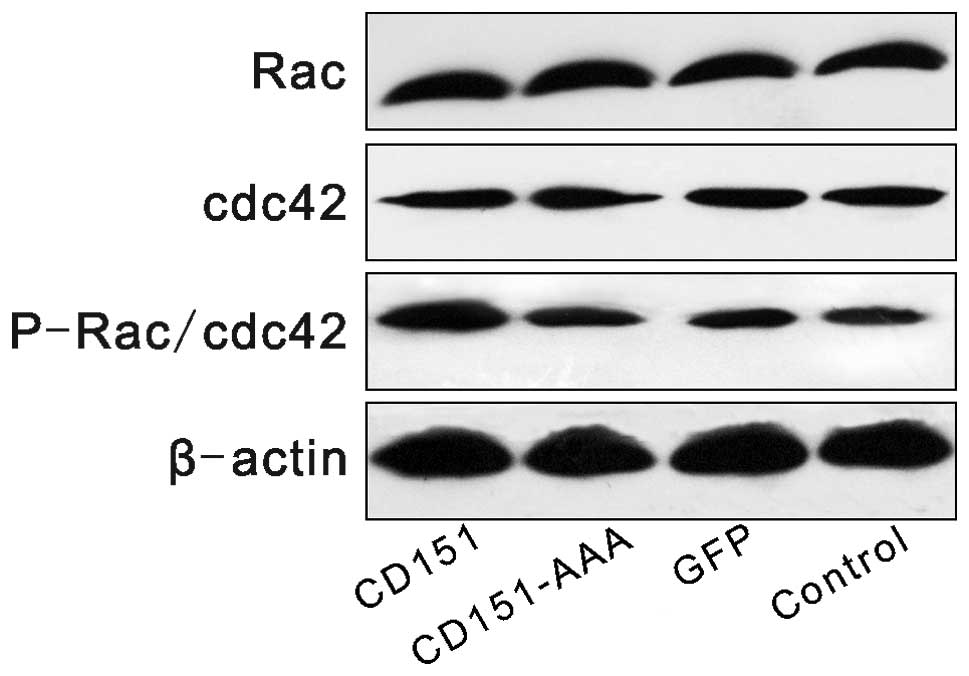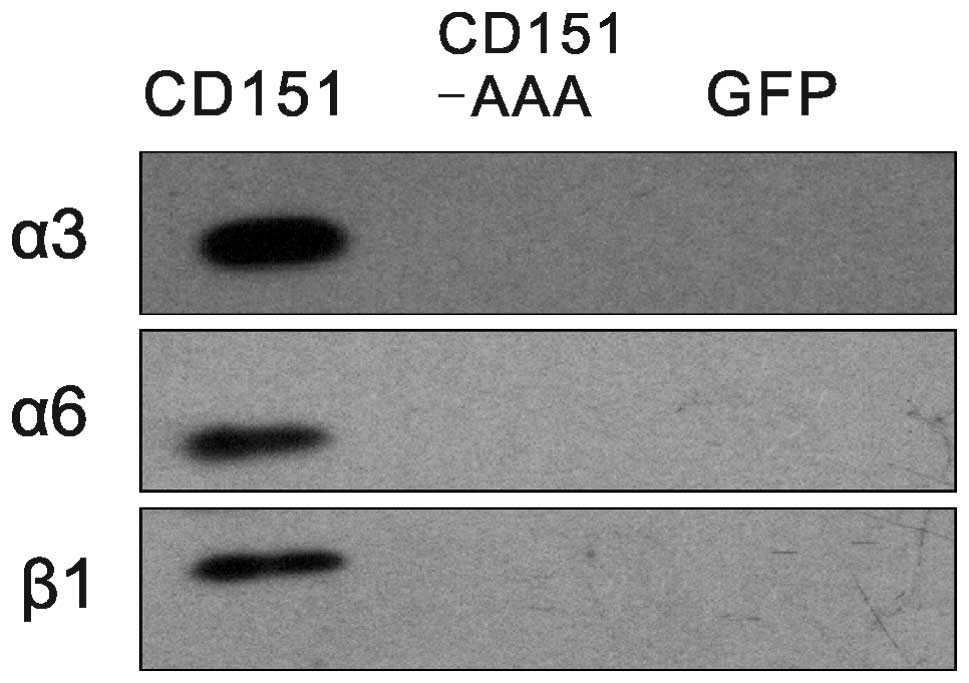CD151 promotes cancer cell metastasis via integrins α3β1 and α6β1 in vitro
- Authors:
- Published online on: September 24, 2012 https://doi.org/10.3892/mmr.2012.1095
- Pages: 1226-1230
Abstract
Introduction
The tetraspanins (TM4SF) are a family of membrane proteins that are charaterized by the presence of four highly conserved transmembrane domains (1). They have a small intracellular loop, intracellular N- and C-termini with short cytoplasmic tails and two extracellular loops, the larger of which contains a distinctive pattern of cysteine residues that helps to define the family (2). The tetraspanin superfamily member CD151 (also named PETA-3/SFA-1), is implicated in various biological processes, including cell adhesion, signal tranduction, cell proliferation, cell differentiation, pathological angiogenesis and metastasis (3,4). CD151 is found in a large variety of cell types, including the epithelia, endothelia, platelets and smooth and striated muscles (5,6). CD151 forms complexes by interacting with other tetraspanins or non-tetraspanins to exert its effects; the most prominent non-tetraspanin partners are integrins, particularly α3β1 and α6β1 (7). A previous study revealed that an extracellular CD151 site, QRD194-196, in the larger of the extracellular loops, is required for strong α3β1 association (8).
A number of studies have shown that CD151 is related to numerous different types of carcinoma, including prostate cancer, pancreatic cancer, breast cancer, colorectal cancer and non-small cell lung cancer; in all of them, high CD151 expression is associated with a poor prognosis (9,10). Most of these studies emphasize clinical study. As previously mentioned, CD151 forms complexes with integrins, so we formed a mutant of CD151 QRD194-196, AAA194-196, which may impair the association between CD151 and integrins. We made use of this mutant, taking HepG2 as our target cell line, to examine the role of the CD151-AAA mutant in cell proliferation, migration and invasion, which are the main processes involved in carcinoma metastasis. The purpose of this study was to investigate the function of CD151-integrin complexes in carcinoma metastasis and the mechanism involved.
Materials and methods
Materials
The pZeoSV-CD151 plasmid and anti-CD151 monoclonal antibody (mAb) 5C11 were provided by Professor Xin Zhang, Department of Molecular Science, University of Tennessee Health Science Center (Memphis, TN, USA). Dulbecco’s modified Eagle’s medium (DMEM) culture medium was purchased from Gibco-BRL (Los Angeles, CA, USA). The cell counting kit-8 (CCK-8) was purchased from Beyotime (Haimen, China). The Attractene transfection reagent was from Qiagen (Hilden, Germany). The enhanced chemiluminescent (ECL) substrate was from Thermo Scientific Pierce (Rockford, IL, USA). The polyvinylidene difluoride (PVDF) membrane was from Roche Diagnostics (Basel, Switzerland). Matrigel was purchased from BD Biosciences (Heidelberg, Germany). Mouse anti-human β-actin antibody and antibodies against α3, α6 and β1 were purchased from Santa Cruz Biotechnology, Inc. (Santa Cruz, CA, USA). Antibodies against Rac, cdc42 and phospho-Rac1/cdc42 (P-Rac1/cdc42) were from Cell Signaling Technology, Inc. (Beverly, MA, USA). The protein A/G-agarose kit was from Abmart (Shanghai, China). The study was approved by the ethics committee of Huazhong University of Science and Technology.
Cell culture and plasmid transfection
The HepG2 cell line was bought from the China Center for Type Culture Collection and cultured in DMEM supplemented with 10% fetal bovine serum (FBS), penicillin and streptomycin. The HepG2 cells were grown on 6-well plates (60–80% confluent). The pAAV-CD151 (1.2 μg), pAAV-CD151-AAA (1.2 μg) or pAAV-GFP plasmid (1.2 μg) was mixed with the Attractene transfection reagent (4.5 μl/well) and incubated for 15 min at room temperature. The lipid-coated DNA was then added to each well containing 2 ml DMEM medium and incubated for 6 h. At the end of this period, the medium was removed and replaced with complete medium, after which the HepG2 cells were lysed or used in proliferation, migration and chemotaxis assays.
Western blot analysis
HepG2 cell protein was extracted as follows. Briefly, the medium in the 6-well plates was discarded, and the cells were gently washed three times with cooled PBS. A radioimmunoprecipitation assay (RIPA) buffer [50 mmol/l Tris-HCl (pH 8.0), 150 mmol/l NaCl, 1% Nonidet-P40, 0.5% deoxycholic acid and 0.1% sodium dodecyl sulfate] 150 μl] was then added to each well. Following incubation on ice for 30 min, the lysate was centrifuged at 12,000 × g at 4°C for 20 min. The protein concentration of the supernatant was determined using the bicinchoninic acid (BCA) method. Lysates (25 μg protein/lane) were resolved by SDS-PAGE gel and transferred to PVDF membranes which were then blocked with 20% non-fat dry milk in 10 mmol/l Tris-HCl, pH 7.5, 100 mmol/l NaCl and 0.1% Tween-20. The membranes were then incubated with primary antibodies against CD151, β-actin, Rac, cdc42 and P-Rac/cdc42 overnight at 4°C. Peroxidase-conjugated secondary antibodies were applied for 2–3 h. An ECL system was used to visualize the separated proteins. The intensities of the various protein bands were quantified by densitometry (using GeneTools analysis software).
Proliferation assay
The HepG2 cells were transfected with pAAV-CD151, pAAV-CD151-AAA or pAAV-GFP using the Attractene transfection reagent in 6-well plates in triplicate, and 24 h later the cells were trypsinized and seeded in 96-well plates in triplicate (2,000 cells/well). After attachment, CCK-8 solution (10 μl/well) was added to the cells, which were then incubated for 1 h. The absorbance was measured at 450 nm for each well using a microplate reader (Bio-Tek Instruments, Inc., Winooski, VT, USA) according to the manufacturer’s instructions.
Wound healing assay
Cell migration was assessed in a wound healing assay. The HepG2 transfectant cells were cultured in 24-well plates. When monolayers had formed, wounds were generated by scraping the monolayers with the tips of sterile pipettes. The detached cells were rinsed away with PBS and the wounded monolayers were replenished with the complete medium. Following 12 h of culturing at 37°C, the monolayers were fixed and images captured under an inverted light microscope (Nikon TE2000; Nikon, Tokyo, Japan).
Matrigel invasion assay
The HepG2 transfectant cells were detached from the culture plates with EDTA, washed once with PBS and replated onto the inserts of 8-μm pore sized Costar Transwell chambers (Corning Inc., Corning, NY, USA). The undersides of the inserts were pre-coated with matrigel (0.3 mg/ml) at 37°C overnight. The cell number was between 1×105 and 5×105 cells/ml. The media included DMEM containing 10% FBS in the lower wells and DMEM containing 0.1% heat-inactivated bovine serum albumin in the insert. Following incubation at 37°C for 12–18 h, cells that had not migrated through the inserts were removed and cells that had migrated to the undersides of the inserts were fixed and stained. Cells on the lower surface of the membranes were counted. Data from independent experiments were pooled and analyzed using a two-tailed Student’s t-test.
Immunoprecipitation
The cells were lysed with ice-cold modified RIPA buffer at 4°C for 30 min. Adherent cells were scraped off the dish with a plastic cell scraper. Following the removal of the insoluble material by 14,000 × g centrifugation, the pre-cleared lysates were incubated with primary mAb (5C11) pre-absorbed onto protein A- and G-agarose beads from 3 h to overnight at 4°C. The precipitates were washed with the lysis buffer three times, dissolved in 1X SDS loading buffer, heated at 100°C for 10 min, separated by SDS-PAGE and then electrically transferred to PVDF membranes. After blocking for 2.5 h in 20% non-fat dry milk in TBST, the membrane was incubated with anti-α3, anti-α6 or anti-β1 antibody overnight at 4°C. After washing with TBST, the membrane was incubated with horseradish peroxidase-conjugated secondary antibodies for 2–3 h at room temperature and was then revealed by chemiluminescence.
Statistical analysis
All data are expressed as the mean ± standard deviation (x±s). Differences between two groups were compared by t-test and comparisons of groups were performed via one-way analysis of variance (ANOVA) and the Student-Newman-Keuls test. Statistical analysis was performed using SPSS 13.0 software. P<0.05 was considered to indicate a statistically significant result.
Results
Expression of CD151 protein in different groups
The expression levels of CD151 in the cells transfected with the pAAV-CD151 plasmid were significantly increased (P<0.05) compared with the control and pAAV-GFP groups 48 h after transfection. In addition, the cells transfected with pAAV-CD151-AAA demonstrated no significant difference in protein expression levels from the pAAV-CD151 group (P>0.05) (Fig. 1)
Effect of CD151 and CD151-AAA on HepG2 proliferation
To determine the effect of CD151 on HepG2 proliferation, we used a CCK-8 assay. The transfection of the HepG2 cells with the pAAV-CD151 plasmid significantly enhanced the HepG2 proliferation (P<0.05) compared with the pAAV-GFP-transfected and control groups. Transfection with pAAV-CD151-AAA also significantly enhanced the proliferation of the cells as compared with the groups transfected with pAAV-GFP and the control (Fig. 2). The results indicated that pAAV-CD151 was able to promote cell proliferation, while the ability of pAAV-CD151-AAA to promote cell proliferation was decreased compared with the pAAV-CD151 group.
Effect of CD151 and CD151-AAA on HepG2 migration
In the wound healing assay (Fig. 3), the cells transfected with pAAV-CD151 demonstrated significantly enhanced wound healing, The ability of the pAAV-CD151-AAA mutant cells to undergo wound healing was markedly delayed compared with the pAAV-CD151 transfectant cells. The wound healing assay demonstrated that pAAV-CD151 gene transfer was able to promote HepG2 migration and that this effect was diminished in the pAAV-CD151-AAA group.
Effect of CD151 and CD151-AAA on HepG2 invasion
In the matrigel invasion assay (Fig. 4), pAAV-CD151 significantly promoted HepG2 invasion compared with the control and pAAV-GFP groups. pAAV-CD151-AAA was not able to promote cell invasion, which suggests that this ability was damaged in the pAAV-CD151-AAA group.
Effect of CD151 and CD151-AAA on the Rac, cdc42 and P-Rac/cdc42 pathways
The expression levels of Rac, cdc42 and P-Rac/cdc42 were investigated following transfection. Western blot analysis revealed that transfection with pAAV-CD151 increased the expression level of phosphorylated P-Rac/cdc42 compared with the control group and the GFP group, whereas transfection with pAAV-CD151-AAA had no effect on the expression levels of P-Rac/cdc42 (Fig. 5).
Effects of the CD151-AAA mutation on the CD151-integrin association
To determine whether the pAAV-CD151-AAA mutant altered the CD151-integrin complexation, we compared the CD151-integrin associations between the CD151 and CD151-AAA transfectants. Immunoblotting analysis indicated that the integrins that were coprecipitated with CD151 (5C11) under the stringent lysis conditions were endogenous α3, α6 and β1 (Fig. 6).
Discussion
In this study, we used the CD151-AAA mutant to investigate the mechanism that governs the effects of CD151 on carcinoma metastasis. Our results revealed that the CD151-AAA mutant strongly inhibited the proliferation, migration and invasion of HepG2 cells. These results demonstrated that the CD151-integrin complex is functionally significant. In our previous study, this mutant was shown to have the ability to impair angiogenesis due to abrogation of the relationship between CD151 and integrins (11).
CD151 has a function in a number of carcinomas. In liver cancer, hepatocellular carcinoma patients with high expression levels of the CD151/integrin β1 complex have been reported to have the poorest prognosis (2). The expression levels of CD151 have been found to correlate positively with clinical classification in clear cell renal cell carcinoma patients; the patients with high CD151 expression levels had significantly shorter survival times (3). For tumors of the gastrointestinal tract, CD151 is indicated to promote metastasis formation (10). In endometrial cancer, CD151 has been identified as a novel marker that may be used to guide therapeutic decisions (12). It has also been reported that CD151 forms a structural and functional complex with integrin α3/α6 that exerts oncogenic functions in human salivary gland cancer cells (13). The expression levels of the CD151-α6 integrin complex have been reported to be elevated in 31% of human breast cancers (14). CD151 expression levels have also been found to be significantly higher in prostate cancer, with poorly differentiated cancers demonstrating the strongest staining (15). Patients with pancreatic adenocarcinoma also revealed high expression levels of CD151, and α6β4 was found to be selectively upregulated (16). In all, CD151 is the most harmful molecule that may be detected in patients with carcinoma and many of its functions are associated with integrins.
CD151 closely associates with laminin-binding integrins (α3β1 and α6β1) and affects their functions (17,18). The CD151 site QRD194-196 is the key site of complex formation between CD151 and integrins. Therefore, in this study we used pAAV-CD151-AAA, which we constructed in our former study by applying the technology of oriented direction mutation, to investigate whether the function of CD151 is weakened without the aid of integrins. The results confirm our hypothesis. This is the first time that we have used the mutant CD151-AAA to study tumor cells. In our former study it was used in the investigation of angiogenesis (11). The mutant CD151-AAA abrogated cell proliferation, migration and invasion ability. Its mechanism may involve the downregulation of P-Rac1/cdc42 activity.
From these findings, it appears that the enhancement of HepG2 cell proliferation, migration and invasion by CD151 is due to P-Rac1/cdc42-mediated events activated by CD151-integrin complexes, but not by CD151 alone. Our study suggests that, since the relationship between CD151 and integrins may be disrupted to result in marked decreases in tumor cell quantity and other effects, interrupting their connection may be a new method to prevent malignant cell metastasis.
Acknowledgements
We thank the Laboratory of Cardiology of Tongji Hospital, Wuhan, China. This study was financially supported by grants from the National Science Foundation for Young Scientists of China (Project No. 81000047 and No. 81000139).
References
|
Wright MD and Tomlinson MG: The ins and outs of the transmembrane 4 superfamily (Review). Immunol Today. 15:588–594. 1994. View Article : Google Scholar : PubMed/NCBI | |
|
Devbhandari RP, Shi GM, Ke AW, et al: Profiling of the tetraspanin CD151 web and conspiracy of CD151/integrin β1 complex in the progression of hepatocellular carcinoma. PLoS One. 6:e249012011.PubMed/NCBI | |
|
Yoo SH, Lee K, Chae JY and Moon KC: CD151 expression can predict cancer progression in clear cell renal cell carcinoma. Histopathology. 58:191–197. 2011. View Article : Google Scholar : PubMed/NCBI | |
|
Takeda Y, Kazarov AR, Butterfield CE, et al: Deletion of tetraspanin Cd151 results in decreased pathologic angiogenesis in vivo and in vitro. Blood. 109:1524–1532. 2007. View Article : Google Scholar : PubMed/NCBI | |
|
Caplan MJ, Kamsteeg EJ and Duffield A: Tetraspan proteins: regulators of renal structure and function (Review). Curr Opin Nephrol Hypertens. 16:353–358. 2007. View Article : Google Scholar : PubMed/NCBI | |
|
Fitter S, Tetaz TJ, Berndt MC and Ashman LK: Molecular cloning of cDNA encoding a novel platelet-endothelial cell tetra-span antigen, PETA-3. Blood. 86:1348–1355. 1995.PubMed/NCBI | |
|
Zöller M: Tetraspanins: push and pull in suppressing and promoting metastasis (Review). Nat Rev Cancer. 9:40–55. 2009.PubMed/NCBI | |
|
Kazarov AR, Yang X, Stipp CS, Sehgal B and Hemler ME: An extracellular site on tetraspanin CD151 determines alpha 3 and alpha 6 integrin-dependent cellular morphology. J Cell Biol. 158:1299–1309. 2002. View Article : Google Scholar : PubMed/NCBI | |
|
Lazo PA: Functional implications of tetraspanin proteins in cancer biology (Review). Cancer Sci. 98:1666–1677. 2007. View Article : Google Scholar : PubMed/NCBI | |
|
Zöller M: Gastrointestinal tumors: metastasis and tetraspanins (Review). Z Gastroenterol. 44:573–586. 2006.PubMed/NCBI | |
|
Liu WF, Zuo HJ, Chai BL, et al: Role of tetraspanin CD151-α3/α6 integrin complex: Implication in angiogenesis CD151-integrin complex in angiogenesis. Int J Biochem Cell Biol. 43:642–650. 2011. | |
|
Voss MA, Gordon N, Maloney S, et al: Tetraspanin CD151 is a novel prognostic marker in poor outcome endometrial cancer. Br J Cancer. 104:1611–1618. 2011. View Article : Google Scholar : PubMed/NCBI | |
|
Klosek SK, Nakashiro K, Hara S, Shintani S, Hasegawa H and Hamakawa H: CD151 forms a functional complex with c-Met in human salivary gland cancer cells. Biochem Biophys Res Commun. 336:408–416. 2005. View Article : Google Scholar : PubMed/NCBI | |
|
Yang XH, Richardson AL, Torres-Arzayus MI, et al: CD151 accelerates breast cancer by regulating alpha 6 integrin function, signaling, and molecular organization. Cancer Res. 68:3204–3213. 2008. View Article : Google Scholar : PubMed/NCBI | |
|
Ang J, Lijovic M, Ashman LK, Kan K and Frauman AG: CD151 protein expression predicts the clinical outcome of low-grade primary prostate cancer better than histologic grading: a new prognostic indicator? Cancer Epidemiol Biomarkers Prev. 13:1717–1721. 2004.PubMed/NCBI | |
|
Gesierich S, Paret C, Hildebrand D, et al: Colocalization of the tetraspanins, CO-029 and CD151, with integrins in human pancreatic adenocarcinoma: impact on cell motility. Clin Cancer Res. 11:2840–2852. 2005. View Article : Google Scholar : PubMed/NCBI | |
|
Sincock PM, Fitter S, Parton RG, Berndt MC, Gamble JR and Ashman LK: PETA-3/CD151, a member of the transmembrane 4 superfamily, is localised to the plasma membrane and endocytic system of endothelial cells, associates with multiple integrins and modulates cell function. J Cell Sci. 112:833–844. 1999.PubMed/NCBI | |
|
Yáñez-Mó M, Alfranca A, Cabañas C, et al: Regulation of endothelial cell motility by complexes of tetraspan molecules CD81/TAPA-1 and CD151/PETA-3 with alpha3 beta1 integrin localized at endothelial lateral junctions. J Cell Biol. 141:791–804. 1998.PubMed/NCBI |















